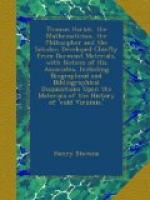Letter 122, dated
Prague, 11 October, 1606,
from John Kepler
to Thomas Hariot,
Kepler had heard of Hariot’s acquirements in Natural Philosophy from his friend John Eriksen. Would be glad to know Hariot’s views as to the origin and essential differences of colours; also on the question of refraction of rays of light; and the causes of the Rainbow; and of haloes round the sun.
Letter 223, dated
London, 11 December,
1606,from
Thomas Hariot to John Kepler,
Had received with pleasure Kepler’s letter; but should not be able to answer it at length, being in indifferent health, so that it was not easy to write or even carefully to reflect. Sends a table of the results of experiments on equal bulks of various liquids and transparent solids (thirteen in number, including spring, rain, and salt water; Spanish and Rhenish wine; vinegar; spirits of wine; oils and glass). The angle of incidence is 30° in each case; also the specific gravity of each substance is given. Then he discusses the reason why refraction takes place. Promises to write on the Rainbow; but will merely say at present that it is to be explained by the reflection on the concave superficies and the refraction at the convex superficies of each separate drop.
Letter 224 is
from John Kepler to Thomas Hariot,
dated at Prague, 11 August,
1607.
Thanks Hariot for his table, which supplies matter for serious consideration. Asks questions as to how he defines the angles of incidence and refraction; and goes on to discuss the reasons of refraction. Agrees with Hariot as to his views about the Rainbow; but will be very glad to receive his treatises on Colours and the Rainbow.
Letter 225 is
from Thomas Hariot to John Kepler,
dated at Syon,
near London, 13 July (o.s.), 1608.
The departure of Eriksen and other matters do not allow leisure to write at length. The turpentine (oleum terebinth inum) was not the same as that experimented on by Kepler but a purer and lighter article (Sp. grav. ’87). The angle of incidence is understood as defined by Alhazen and Vitellio [first published 1572]. Points out some errors in Vitellio’s second table of refractions. As to the causes of refraction, Hariot believes in the theory of the vacuum; ’ where we still stick in the mud ’. Hopes God (Deum optimum maximum) will soon put an end to this. Wishes for Kepler’s meteorological records for the last two years, and will send his own notes in return. Gilbert, author of a work on the magnet, had recently died, leaving in his brother’s hands a book entitled ’ De Globo et Mundo nostro sub lunari Philosophia nova contra Peripateticos, lib. 5.” [A treatise, in five books, on Natural Philosophy, in answer to the Peripatetics.] The book is likely




